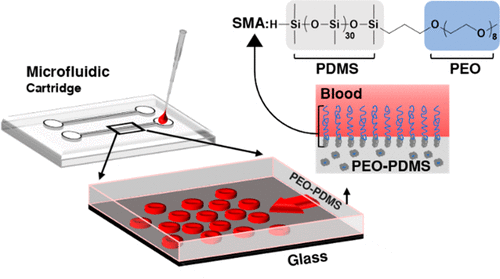当前位置:
X-MOL 学术
›
ACS Appl. Polym. Mater.
›
论文详情
Our official English website, www.x-mol.net, welcomes your
feedback! (Note: you will need to create a separate account there.)
Pumpless, “Self-Driven” Microfluidic Channels with Controlled Blood Flow Using an Amphiphilic Silicone
ACS Applied Polymer Materials ( IF 4.4 ) Pub Date : 2020-03-25 , DOI: 10.1021/acsapm.0c00249 Kokou S. Dogbevi 1 , Bryan Khai D. Ngo 1 , Connor W. Blake 1 , Melissa A. Grunlan 1, 2, 3, 4 , Gerard L. Coté 1, 4
ACS Applied Polymer Materials ( IF 4.4 ) Pub Date : 2020-03-25 , DOI: 10.1021/acsapm.0c00249 Kokou S. Dogbevi 1 , Bryan Khai D. Ngo 1 , Connor W. Blake 1 , Melissa A. Grunlan 1, 2, 3, 4 , Gerard L. Coté 1, 4
Affiliation

|
A silicone microfluidic system that enables the pumpless, controlled flow of blood represents a significant advancement for the improvement of diagnostics and biological research. Such a system would be especially useful toward developing a single use, optical imaged point-of-care (POC) device. While readily used to prepare microfluidics via soft lithography, silicones inhibit capillary flow of blood due to their extreme hydrophobicity. Herein, Sylgard 184 was conveniently modified with a surface modifying additive (SMA) to produce microfluidics having “on-demand” surface hydrophilicity leading to pumpless capillary blood flow. The SMA is a poly(ethylene oxide) (PEO) silane amphiphile composed of a cross-linkable silane (Si–H) end group, an oligodimethylsiloxane (ODMS) tether, and PEO segment: HSi-ODMS30-block-PEO8-OCH3. The SMA was incorporated at different concentrations into the silicone (5, 7, and 14 wt %) and resulting films as well as corresponding microchannels were assessed for key properties relevant to a single use, POC device to analyze blood. Overall, the SMA did not compromise light propagation or increase autofluorescence, which are important parameters for permitting the eventual use of optical detection and imaging methods for analysis of blood within a microfluidic channel. While incorporation of the PEO-silane amphiphile SMA led to an expected decrease in modulus, this did not result in collapse of the channels. The SMA caused a dramatic increase in water-driven surface hydrophilicity, particularly at higher concentrations. As a result of the surface restructuring effect, the modified silicones enabled the pumpless flow of blood through microfluidic channels. Moreover, channel height as well as SMA concentration was useful in controlling the speed of blood flow.
中文翻译:

使用两亲性有机硅,可控制血流的无泵,“自驱动”微流体通道
能够实现无泵,可控的血液流动的有机硅微流体系统代表了诊断学和生物学研究的重大进步。这样的系统对于开发一次性使用的光学成像即时医疗(POC)设备特别有用。虽然有机硅很容易通过软光刻法制备微流体,但有机硅由于其极高的疏水性而抑制了血液的毛细流动。在此,Sylgard 184可以方便地用表面改性添加剂(SMA)进行改性,以产生具有“按需”表面亲水性的微流体,从而导致无泵毛细管血流。所述SMA是聚(环氧乙烷)(PEO)硅烷两亲物的交联性硅烷(的Si-H)的端基组成,一个oligodimethylsiloxane(ODMS)系绳,和PEO段:淅ODMS 30 --PEO 8 -OCH 3嵌段。将SMA以不同的浓度掺入有机硅(5、7和14 wt%)中,并评估所得膜以及相应的微通道的与一次性使用POC装置分析血液相关的关键性能。总体而言,SMA不会损害光传播或增加自发荧光,这是允许最终使用光学检测和成像方法来分析微流体通道内血液的重要参数。尽管PEO-硅烷两亲性SMA的引入导致模量的预期下降,但这并未导致通道塌陷。SMA导致水驱动的表面亲水性急剧增加,尤其是在较高浓度下。由于表面重组的作用,改性有机硅使血液能够通过微流体通道无泵流动。此外,通道高度以及SMA浓度可用于控制血流速度。
更新日期:2020-04-23
中文翻译:

使用两亲性有机硅,可控制血流的无泵,“自驱动”微流体通道
能够实现无泵,可控的血液流动的有机硅微流体系统代表了诊断学和生物学研究的重大进步。这样的系统对于开发一次性使用的光学成像即时医疗(POC)设备特别有用。虽然有机硅很容易通过软光刻法制备微流体,但有机硅由于其极高的疏水性而抑制了血液的毛细流动。在此,Sylgard 184可以方便地用表面改性添加剂(SMA)进行改性,以产生具有“按需”表面亲水性的微流体,从而导致无泵毛细管血流。所述SMA是聚(环氧乙烷)(PEO)硅烷两亲物的交联性硅烷(的Si-H)的端基组成,一个oligodimethylsiloxane(ODMS)系绳,和PEO段:淅ODMS 30 --PEO 8 -OCH 3嵌段。将SMA以不同的浓度掺入有机硅(5、7和14 wt%)中,并评估所得膜以及相应的微通道的与一次性使用POC装置分析血液相关的关键性能。总体而言,SMA不会损害光传播或增加自发荧光,这是允许最终使用光学检测和成像方法来分析微流体通道内血液的重要参数。尽管PEO-硅烷两亲性SMA的引入导致模量的预期下降,但这并未导致通道塌陷。SMA导致水驱动的表面亲水性急剧增加,尤其是在较高浓度下。由于表面重组的作用,改性有机硅使血液能够通过微流体通道无泵流动。此外,通道高度以及SMA浓度可用于控制血流速度。









































 京公网安备 11010802027423号
京公网安备 11010802027423号